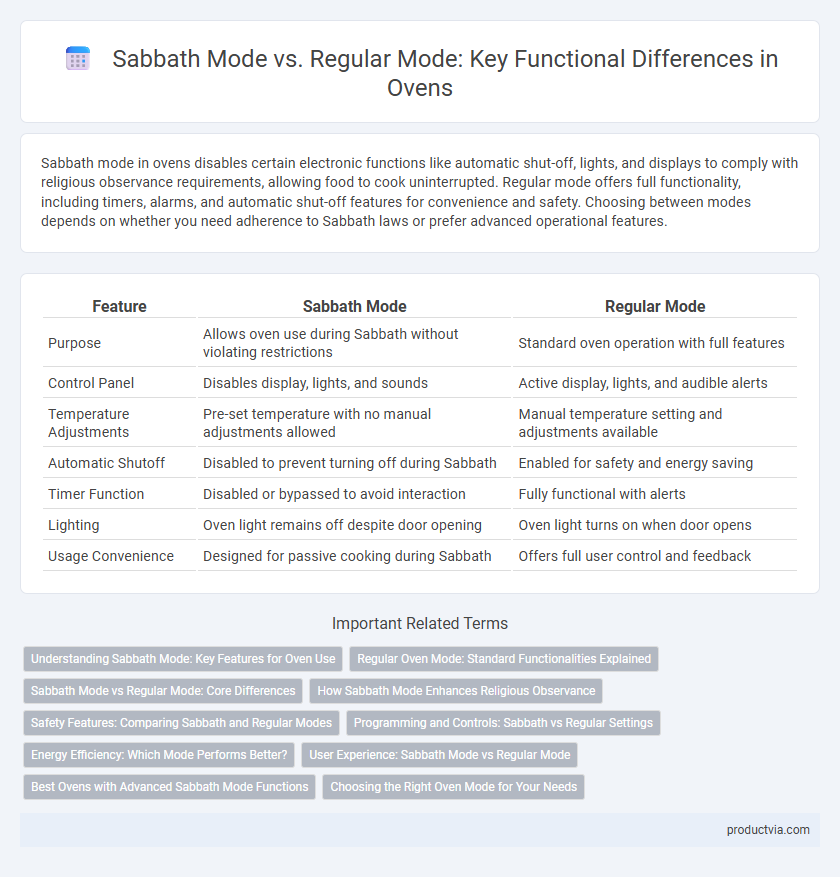Sabbath mode in ovens disables certain electronic functions like automatic shut-off, lights, and displays to comply with religious observance requirements, allowing food to cook uninterrupted. Regular mode offers full functionality, including timers, alarms, and automatic shut-off features for convenience and safety. Choosing between modes depends on whether you need adherence to Sabbath laws or prefer advanced operational features.
Table of Comparison
| Feature | Sabbath Mode | Regular Mode |
|---|---|---|
| Purpose | Allows oven use during Sabbath without violating restrictions | Standard oven operation with full features |
| Control Panel | Disables display, lights, and sounds | Active display, lights, and audible alerts |
| Temperature Adjustments | Pre-set temperature with no manual adjustments allowed | Manual temperature setting and adjustments available |
| Automatic Shutoff | Disabled to prevent turning off during Sabbath | Enabled for safety and energy saving |
| Timer Function | Disabled or bypassed to avoid interaction | Fully functional with alerts |
| Lighting | Oven light remains off despite door opening | Oven light turns on when door opens |
| Usage Convenience | Designed for passive cooking during Sabbath | Offers full user control and feedback |
Understanding Sabbath Mode: Key Features for Oven Use
Sabbath mode on an oven disables automatic shut-off, light activation, and digital displays to comply with religious observance requirements during the Sabbath, allowing food to cook without manual intervention. Regular mode offers full functionality, including timer settings, display updates, and sensor controls for everyday cooking convenience. Understanding these key features helps users select the appropriate mode for either uninterrupted Sabbath use or typical culinary tasks.
Regular Oven Mode: Standard Functionalities Explained
Regular Oven Mode offers standard baking, roasting, and broiling functions with precise temperature control and timer settings, suitable for everyday cooking needs. Unlike Sabbath mode, which disables certain features to comply with religious observance, Regular Oven Mode allows full access to preheating, convection fan operation, and sensor-based cooking adjustments. This mode ensures optimal cooking performance with features like self-cleaning and automatic shut-off for convenience and safety.
Sabbath Mode vs Regular Mode: Core Differences
Sabbath Mode on ovens disables automatic features such as lights, alarms, and digital displays to comply with religious restrictions during the Sabbath, while Regular Mode operates all functionalities normally. In Sabbath Mode, users manually set the temperature before the Sabbath begins, and the oven maintains a consistent temperature without user interaction. Regular Mode offers full control with real-time adjustments, sensor-driven cooking, and energy-saving features.
How Sabbath Mode Enhances Religious Observance
Sabbath mode on ovens disables automatic shutoff, lights, and digital displays, allowing uninterrupted cooking during religious observances such as the Jewish Sabbath. This feature respects prohibitions against operating electrical appliances while ensuring food remains warm and safe to eat. Regular mode lacks these adjustments, making Sabbath mode essential for maintaining adherence to religious laws without sacrificing functionality.
Safety Features: Comparing Sabbath and Regular Modes
Sabbath mode on ovens disables automatic shut-off and certain lights to comply with religious observances, enhancing safety by preventing accidental interruptions during use. Regular mode offers automatic safety features like timer shut-off and temperature alerts, designed to prevent overheating and accidents. Understanding these distinctions ensures users select the appropriate mode for both compliance and optimal safety during cooking.
Programming and Controls: Sabbath vs Regular Settings
Sabbath mode on ovens adjusts programming by disabling automatic shutoff and digital displays to comply with religious observances, while regular mode allows full use of digital controls and timed settings for convenience. In Sabbath mode, manual intervention is minimized, preventing changes once the oven is activated, unlike regular mode which supports customizable temperature and timer adjustments. Controls in Sabbath mode rely on preset or mechanical inputs, contrasting with the touch-based programming flexibility available in regular oven settings.
Energy Efficiency: Which Mode Performs Better?
Sabbath mode in ovens is designed to comply with religious restrictions by disabling automatic shut-off and certain electrical functions, which may lead to continuous energy consumption during operation. Regular mode optimizes energy use by cycling heating elements on and off based on temperature settings, resulting in better energy efficiency. For those prioritizing energy savings, regular mode generally performs better than Sabbath mode due to its active energy regulation features.
User Experience: Sabbath Mode vs Regular Mode
Sabbath mode in ovens disables automatic shut-off, lights, and displays to comply with religious observance requirements, ensuring uninterrupted cooking without manual intervention. Regular mode offers full functionality, including precise temperature control, timer settings, and user-friendly interfaces for everyday cooking convenience. Users seeking compliance with Sabbath laws benefit from Sabbath mode's simplified controls, while those prioritizing flexibility and advanced features prefer regular mode.
Best Ovens with Advanced Sabbath Mode Functions
Best ovens with advanced Sabbath mode functions offer precise temperature control and timer settings compliant with Sabbath observance, preventing automatic shutoff and allowing safe use without violating religious laws. These models often include features like non-volatile digital displays, delayed start, and locked controls that disable touchscreens or buttons during the Sabbath. Investing in ovens with dedicated Sabbath mode options ensures functionality, safety, and convenience for users requiring strict adherence to Sabbath restrictions.
Choosing the Right Oven Mode for Your Needs
Sabbath mode on ovens disables certain electronic functions like automatic shutoff and interior lights to comply with religious observance requirements, ensuring uninterrupted cooking during the Sabbath. Regular mode offers full control with features such as timers, automatic shutoff, and enhanced safety settings for everyday convenience. Selecting the right mode depends on whether consistent manual control or adherence to specific religious practices is prioritized for your cooking needs.
Sabbath mode vs Regular mode for functionality Infographic

 productvia.com
productvia.com